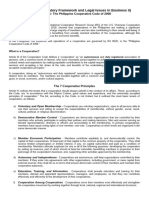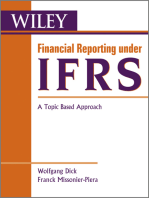Lesson 4
Lesson 4
Uploaded by
Vidal Angel Glory Borj A.Copyright:
Available Formats
Lesson 4
Lesson 4
Uploaded by
Vidal Angel Glory Borj A.Copyright
Available Formats
Share this document
Did you find this document useful?
Is this content inappropriate?
Copyright:
Available Formats
Lesson 4
Lesson 4
Uploaded by
Vidal Angel Glory Borj A.Copyright:
Available Formats
LESSON 4
CLASSIFICATION & TYPES OF COOPERATIVES and
PROVISIONS ON MEMBERSHIP
TOPICS
1. Classification of Cooperatives
2. Important Provisions on Membership
3. Types of Cooperatives
LEARNING OUTCOMES
At the end of the lesson, you should be able to:
1. Identify and describe the classification and types of cooperatives;
2. Give examples of the activities of the different types of cooperatives;
3. Discuss the rights and duties of members of a cooperative; and
4. Explain how membership is terminated;
TOPIC 1: CLASSIFICATION OF COOPERATIVES
1. According to Membership:
a. PRIMARY – the members of which are natural persons of legal age;
Who may become members of a Primary Cooperative?
If you are a Filipino of legal age, you can be a coop member if you meet the
qualifications prescribed by the cooperative’s by-laws.
The board of directors act on application for membership.
A member may exercise his rights only after having paid the fees for membership
and acquired shares in the cooperative.
What are the kinds of membership in the Cooperative?
A cooperative has two kinds of members: 1) regular members and 2) associate
members.
A regular member is entitled to all the rights and privileged of membership as stated
in the Cooperative Code and the coops by- laws.
An associate member has no right to vote and to be voted upon and is entitled to
such rights and privileged provided by the cooperatives by laws.
NOTE: An associate who meets the minimum requirements of regular membership,
continues to patronize the cooperative for two (2) years, and signifies his/her
intention to remain a member shall be considered a regular member. (Art 26 p.2,
RA9520)
What is the Minimum Number of members in a Cooperative?
Fifteen (15) natural persons of legal age who are citizens of the Philippines.
1|Les s on 4- Clas s ification a nd Members hip
b. SECONDARY – the members of which are primaries;
c. TERTIARY - The members of which are secondaries upward to one or more apex
organizations. Cooperatives whose members are cooperatives are called federations or
unions.
2) According to territory
Cooperatives are categorized according to areas of operations which may or may not
coincide with the political subdivisions of the country.
3) Laboratory Cooperative – a cooperative organized by minors must be affiliated with a
registered cooperative and shall be governed by the guidelines by the the CDA. Refer to MC 2015-
03/ Guidelines for the creation and, supervision and monitoring of Laboratory Cooperatives,
August 18, 2015.
TOPIC 2: TYPES OF COOPERATIVES in the PHILIPPINES
1) Credit Cooperative – is one that promotes and undertakes savings and lending services
among its members. It generates a common pool of funds in order to provide financial
assistance and other related financial services to its
members for productive and provident purposes;
2) Consumer’s Cooperative – is one the primary
purpose of which is to procure and distribute
commodities to members and non-members;
3) Producer’s Cooperative – is one that undertakes a
joint production whether agricultural or industrial.
It is formed and operated by its members to
undertake the production and processing of raw
materials or goods produced by its members into finished or processed products for sale
by the cooperative to its members and non-members. Any end product or its derivative
arising from the raw materials produced by its members, sold in the name and for the
account of the cooperative, shall be deemed a product of the cooperative and its
members;
4) Marketing Cooperative – is one which engages in the supply of production inputs to
members and markets their products;
5) Service Cooperative – is one which engages in medical and dental care, hospitalization,
transportation, insurance, housing, labor, electric .light and power, communication,
professional and other services;
6) Multipurpose Cooperative – is one which combines two (2) or more of the business
activities of these different types of cooperatives;
7) Advocacy Cooperative – is a primary cooperative which promotes and advocates
cooperativism among its members and the public through socially-oriented projects,
education and training, research and communication, and other similar activities to reach
out to its intended beneficiaries;
8) Agrarian Reform Cooperative – is one organized by marginal farmers majority of which are
agrarian reform beneficiaries for the purpose of developing an appropriate system of land
tenure, land development, land consolidation or land management in areas covered by
agrarian reform;
9) Cooperative Bank – is one organized for the primary purpose of providing a wide range of
financial services to cooperatives and their members;
2|Les s on 4- Clas s ification a nd Members hip
10) Dairy Cooperative – is one whose members are engaged in the production of fresh milk
which may be processed and/or -marketed as dairy products;
11) Education Cooperative – is one organized for the primary purpose of owning and operating
licensed educational institutions, notwithstanding the provisions of Republic Act No. 9155,
otherwise known as the Governance of Basic Education Act of 2001;
12) Electric Cooperative – is one organized for the primary purpose of undertaking power
generation, utilizing renewable energy sources, including hybrid systems, acquisition and
operation of sub-transmission or distribution to its household members;
13) Financial Service Cooperative – is one organized for the primary purpose of engaging in
savings and credit services and other financial services;
14) Fishermen Cooperative – is one organized by marginalized fishermen in localities whose
products are marketed either as fresh or processed products;
15) Health Services Cooperative – is one organized for the primary purpose of providing
medical, dental and other health services;
16) Housing Cooperative – is one organized to assist or provide, access to housing for the
benefit of its regular members who actively participate in the savings program for housing.
It is co-owned and controlled by its members;
17) Insurance Cooperative – is one engaged in the business of insuring life and property of
cooperatives and their members;
18) Transport Cooperative – is one which includes land and sea transportation, limited to small
vessels, as defined or classified under the Philippine maritime laws, organized under the
provisions of this Code;
19) Water Service Cooperative – is one organized to own, operate and manage water systems
for the provision and distribution of potable water for its members and their households;
20) Worker’s Cooperative – is one organized by workers, including the self-employed, who are
at the same time the members and owners of the enterprise. Its principal purpose is to
provide employment and business opportunities to its members and manage it in
accordance with cooperative principles; and
Other types of cooperative as may be determined by the CDA. The types of
cooperatives are defined in the Joint Rules and Regulations for the taxation of
cooperatives, issued pursuant to the Philippine Cooperative Code of 2008 (RA 9520).
TOPIC 3: PROVISIONS ON MEMBERSHIP
Application for Membership.
An applicant shall be deemed a member after approval of his membership by the board of
directors and shall exercise the rights of member after having made such payments to the
cooperative in respect to membership or acquired interest in the cooperative as may be
prescribed in the bylaws.
If refused or denied by the board of directors, an appeal may be made to the general
assembly and the latter's decision shall be final.
For this purpose, the general assembly may opt to create an appeal and grievance
committee, the members of which shall serve for a period of one (1) year and shall
decide appeals on membership application within thirty (30) days upon receipt thereof. If
the committee fails to decide within the prescribed period, the appeal is deemed
approved in favor of the applicant.
(Art 28, RA 9520)
3|Les s on 4- Clas s ification a nd Members hip
Duties and Responsibilities of a Member.
a) Pay the installment of his/her share capital subscription as it falls due and to participate in the
capital build-up and savings mobilization activities of the Cooperative;
b) Patronize the Cooperative’s business(es) and services;
c) Participate in the membership education programs and other activities and affairs of the
Cooperative;
d) Attend and participate in the deliberation of all matters taken during General Assembly meetings;
and
e) Observe and obey all lawful orders, decisions, rules and regulations adopted by the Board of
Directors and the General Assembly. (Indicated in the by Laws)
Rights and Privileges of Members.
Regular Members
a) Attend general membership meetings;
b) Avail himself of the services of the Cooperative, subject to certain conditions as may be
prescribed by the Board of Directors;
c) Inspect and examine the books of accounts, the audited financial statements, the minutes
books, the share register, and other records of the Cooperative during reasonable office
hours;
d) Secure copies of Cooperative records/documents pertaining to the account information of
the concerned member;
e) Participate in the continuing education and other training programs of the Cooperative;
and
f) Such other rights and privileges as may be granted by the General Assembly (Indicated in
the by Laws).
Associate Members
a) Attend general membership meetings;
b) Avail themselves of the services of the Cooperative, subject to certain conditions as may
be prescribed by the Board of Directors;
c) Inspect and examine the books of accounts, the audited financial statements, the minutes
books, the share register, and other records of the Cooperative during reasonable office
hours;
d) Secure copies of Cooperative records/documents pertaining to the account information of
the concerned member;
e) Such other rights and privileges as may be granted by the General Assembly (Indicated in
the by Laws).
Conditions for a Regular Members Entitled to Vote.
a) Paid the membership fee and the value of the minimum shares required for membership;
b) Not delinquent in the payment of his/her share capital subscriptions and other accounts
or obligations;
c) Has completed the continuing education program prescribed by the Board of Directors;
d) Has participated in the affairs of the Cooperative and patronized its businesses in
accordance with Cooperative’s policies and guidelines; (Indicated in the by Laws)
Failure of the member to meet any of the above conditions shall mean suspension of
voting until the same have been lifted upon the determination of the Board of
Directors.
4|Les s on 4- Clas s ification a nd Members hip
ADDITIONAL RIGHTS A MEMBER ENTITLED TO VOTE:
a. Participate and vote on all matters deliberated upon during General Assembly meetings;
b. Seek any elective or appointive position, subject to the provisions of this By-laws and the
Philippine Cooperative Code of 2008; and
c. Such other rights and privileges as may be provided by the General Assembly.
Nota Bene: Enumerations provided herein are not exclusive, members may include other
rights, privileges and duties in their by laws.
Liability of Members.
A member shall be liable for the debts of the Cooperative only to the extent of his/her
subscribed share capital.
Termination of Membership.
Termination of membership may be automatic, voluntary or involuntary, which shall have the
effect of extinguishing all rights of a member in the Cooperative, subject to refund of share
capital contributions.
a) Automatic Termination of Membership.
The death or insanity of a member shall be considered an automatic termination of
his/her membership in the Cooperative: Provided, however, that in case of death or
insanity of a member of a Cooperative, the next-of-kin shall assume the duties and
responsibilities of the original member.
Failure of the associate member to meet the minimum requirement of regular
membership, to continue to patronize the products and services of the Cooperative for
two (2) years, and signify his/her intention to become regular member shall automatically
terminate his/her membership.
a. Voluntary Termination.
A member may, for any valid reason, withdraw his/her membership from the
Cooperative by giving a sixty (60) day notice to the Board of Directors.
b. Involuntary Termination.
A member may be terminated by a vote of the majority of all the members of the
Board of Directors for any of the following causes:
i. Has not patronized the service(s)/business(es) of the Cooperative as
provided for in the policies of the cooperative;
ii. Has continuously failed to comply with his/her obligations as provided for
in the policies of the Cooperative;
iii. Has violated any provision of this By-laws and the policies of the
Cooperative; and
iv. For any act or omission injurious or prejudicial to the interest or the welfare
of the Cooperative, as defined by the General Assembly Section
(Art 30, RA9520, indicated also in the by laws).
5|Les s on 4- Clas s ification a nd Members hip
ASSESSMENT:
I. TRUE or FALSE. Write T if the statement is correct and F if it is otherwise.
____1. Members of primary cooperatives are juridical persons.
____2. Membership in a cooperative may be regular and irregular members.
____3. Laboratory Cooperatives are organized by minors.
____4. As a general rule, an applicant shall be deemed a member only after approval of his
membership by the general assembly and shall exercise the rights of member after
having made such payments to the cooperative.
____5. Cooperatives are categorized according to areas of operations which may or may not
coincide with the political subdivisions of the country.
____6. A member shall be liable for the debts of the Cooperative only to the extent of
his/her personal properties.
____7. Termination of membership may be automatic, voluntary or involuntary, which shall have
the effect of extinguishing all rights of a member in the Cooperative.
____8. A member may at anytime and for any reason may withdraw his/her membership
from the Cooperative.
____9. Minimum of 15 persons of legal age who are residents of the of the Philippines may
form a cooperative.
____10. An associate member has no right to vote and to be voted upon and is entitled to
such rights and privileged provided by the cooperatives by laws.
II. Write the letter of the TYPES of COOPERATIVES that best describes the given statements.
a. Advocacy Cooperative k. Health Services Cooperative
b. Agrarian Reform Cooperative l. Housing Cooperative
c. Credit Cooperative m. Insurance Cooperative
d. Consumer’s Cooperative n. Producer’s Cooperative
e. Cooperative Bank o. Marketing Cooperative
f. Dairy Cooperative p. Multipurpose Cooperative g.
Education Cooperative q. Service Cooperative
h. Electric Cooperative r. Transport Cooperative
i. Financial Service Cooperative s. Worker’s Cooperative
j. Fishermen Cooperative t. Water Service Cooperative
_____1. Its principal purpose is to provide employment and business opportunities to its members
and manage it in accordance with cooperative principles.
_____2. Organized to assist or provide, access to housing for the benefit of its regular members
who actively participate in the savings program for housing.
_____3. Organized for the primary purpose of owning and operating licensed educational
institutions.
6|Les s on 4- Clas s ification a nd Members hip
_____4. One that promotes and undertakes savings and lending services among its members.
_____5. One which combines two (2) or more of the business activities of these different types of
cooperatives.
_____6. One which engages in medical and dental care, hospitalization, transportation, insurance,
housing, labor, electric, light and power, communication, professional and other services.
_____7. One which engages in the supply of production inputs to members and markets their
products.
_____8. The primary purpose of which is to procure and distribute commodities to members and
non-members.
_____9. One which includes land and sea transportation, limited to small vessels, as defined or
classified under the Philippine maritime laws, organized under the provisions of this Code.
_____10. It is formed and operated by its members to undertake the production and processing of
raw materials or goods produced by its members into finished or processed products for sale
by the cooperative to its members and non-members.
_____11. Organized for the primary purpose of providing a wide range of financial services to
cooperatives and their members.
_____12. One organized for the primary purpose of providing medical, dental and other health
services.
_____13. One organized to own, operate and manage water systems for the provision and
distribution of potable water for its members and their households.
_____14. A primary cooperative which promotes and advocates cooperativism among its members
and the public through socially-oriented projects, education and training, research and
communication, and other similar activities to reach out to its intended beneficiaries.
_____15. One organized by marginalized fishermen in localities whose products are marketed
either as fresh or processed products.
_____16. One engaged in the business of insuring life and property of cooperatives and their
members.
_____17. One organized by marginal farmers majority of which are agrarian reform beneficiaries for
the purpose of developing an appropriate system of land tenure, land development, land
consolidation or land management in areas covered by agrarian reform.
_____18. One whose members are engaged in the production of fresh milk which may be processed
and/or -marketed as dairy products.
_____19. One organized for the primary purpose of engaging in savings and credit services and other
financial services.
_____20. One organized for the primary purpose of undertaking power generation, utilizing
renewable energy sources, including hybrid systems, acquisition and operation of sub-
transmission or distribution to its household members.
7|Les s on 4- Clas s ification a nd Members hip
You might also like
- T24 Accounting Introduction R16Document179 pagesT24 Accounting Introduction R16adyani_0997100% (9)
- Cooperatives Republic Act No. 9520 Philippine Cooperative Code of 2008Document60 pagesCooperatives Republic Act No. 9520 Philippine Cooperative Code of 2008xinfamousxNo ratings yet
- Formulas For SOA/CAS Exam FM/2Document15 pagesFormulas For SOA/CAS Exam FM/2jeff_cunningham_11100% (3)
- Chapter I: General Concepts and PrinciplesDocument13 pagesChapter I: General Concepts and PrinciplesAlondra ManuayNo ratings yet
- The Philippine Cooperative Code of 2008 Republic Act No 9520Document45 pagesThe Philippine Cooperative Code of 2008 Republic Act No 9520J-bae Senairp100% (4)
- Law Topics: Cooperatives (Part 1 of 2) : What Specific Points Will Be Asked From This Topic?Document11 pagesLaw Topics: Cooperatives (Part 1 of 2) : What Specific Points Will Be Asked From This Topic?Liana Monica Lopez100% (1)
- Cooperative Slides May 2022Document37 pagesCooperative Slides May 2022CPAREVIEWNo ratings yet
- Law Topics: Cooperatives (Part 1 of 2) : What Specific Points Will Be Asked From This Topic?Document11 pagesLaw Topics: Cooperatives (Part 1 of 2) : What Specific Points Will Be Asked From This Topic?Christian Dave FernandezNo ratings yet
- Cooperative Law HandoutsDocument12 pagesCooperative Law HandoutsAngelica Nicole TamayoNo ratings yet
- Business Laws and Regulations Session Topic 1: The Cooperative Code of The Philippines Learning OutcomesDocument6 pagesBusiness Laws and Regulations Session Topic 1: The Cooperative Code of The Philippines Learning OutcomesYolly DiazNo ratings yet
- Reviewer CoopDocument7 pagesReviewer CoopemmanuelpantuacolbeNo ratings yet
- Types and Categories or Cooperative - LawsDocument2 pagesTypes and Categories or Cooperative - LawsQueen Valle100% (1)
- New Microsoft Office Word DocumentDocument6 pagesNew Microsoft Office Word DocumentErwin NunezNo ratings yet
- RFBT - Law On CooperativesDocument6 pagesRFBT - Law On CooperativeseunicemaraNo ratings yet
- Ra 9520Document32 pagesRa 9520syhyyh75% (4)
- Philippine Cooperative Code - NotesDocument5 pagesPhilippine Cooperative Code - NotesKenneth Bryan Tegerero Tegio100% (3)
- Toaz - Info Philippine Cooperative Code Notes PRDocument5 pagesToaz - Info Philippine Cooperative Code Notes PRPia TumambingNo ratings yet
- Coop. CodeDocument6 pagesCoop. CodeOdetzkie HolamNo ratings yet
- RFBT 4Document5 pagesRFBT 4Kahayag 00No ratings yet
- Republic Act No. 9520: "Philippine Cooperative Code of 2008"Document9 pagesRepublic Act No. 9520: "Philippine Cooperative Code of 2008"abcdefgNo ratings yet
- How To Organize A CooperativeDocument7 pagesHow To Organize A CooperativeKheen AndalNo ratings yet
- Cooperatives and InsuranceDocument21 pagesCooperatives and InsuranceJordan MichaelNo ratings yet
- Ra 07 BLR302 CooperativesDocument7 pagesRa 07 BLR302 CooperativesSatrify SNNo ratings yet
- 2nd PMES-JATCCODocument67 pages2nd PMES-JATCCOAlliah Gianne JacelaNo ratings yet
- Cooperative: An OverviewDocument27 pagesCooperative: An OverviewJanet T. CometaNo ratings yet
- CooperativesDocument29 pagesCooperativesJOHN DAVID WONG MADRONANo ratings yet
- Cooperative in The PhilippinesDocument27 pagesCooperative in The Philippinesacctg2012100% (1)
- Law On Cooperatives and Security RegulationDocument2 pagesLaw On Cooperatives and Security RegulationCleah Waskin100% (1)
- Cooperatives To Liquidation of CooperativeDocument70 pagesCooperatives To Liquidation of CooperativeLeopoldo Reuteras Morte II100% (2)
- Types and CategoriesDocument5 pagesTypes and CategoriesJohanna Raissa CapadaNo ratings yet
- Audit of CooperativesDocument19 pagesAudit of CooperativesMa. Hazel Donita DiazNo ratings yet
- Booklet 6 Law On Cooperative - Other Business LawsDocument58 pagesBooklet 6 Law On Cooperative - Other Business LawsSheldon SyndromeNo ratings yet
- Cooperatives (Republic Act No. 9520 A.k, A. Philippine Cooperative Code of 2008)Document14 pagesCooperatives (Republic Act No. 9520 A.k, A. Philippine Cooperative Code of 2008)xinfamousxNo ratings yet
- Pmes2019 PDFDocument111 pagesPmes2019 PDFMaroba K-Value AgriNo ratings yet
- By Laws of The CoopDocument20 pagesBy Laws of The CoopYucef Bahian-AbangNo ratings yet
- Laws RFBT Ii LessonDocument18 pagesLaws RFBT Ii LessonKhryzt Carmina CalluengNo ratings yet
- 4.3 Cooperatives: Regulatory Framework and Legal Issues in BusinessDocument23 pages4.3 Cooperatives: Regulatory Framework and Legal Issues in BusinessChristine Mae Fernandez MataNo ratings yet
- 03 Guide Questions - Audit of CooperativesDocument4 pages03 Guide Questions - Audit of CooperativesSofia MaquiñanaNo ratings yet
- What Is A Cooperative?Document14 pagesWhat Is A Cooperative?Ade BonNo ratings yet
- 1-Preliminaries 1a-Types and Categories of Cooperatives 2-Organization and Registration of Cooperatives 3-AdministrationDocument9 pages1-Preliminaries 1a-Types and Categories of Cooperatives 2-Organization and Registration of Cooperatives 3-AdministrationJeric Lagyaban AstrologioNo ratings yet
- Pre-Membership Education SeminarDocument8 pagesPre-Membership Education SeminarAdri Lum75% (4)
- Group2 CooperativesDocument20 pagesGroup2 CooperativesMark Angelo SonNo ratings yet
- MC 2015-01Document16 pagesMC 2015-01JUVIE DUTERTENo ratings yet
- Lesson 4 - General Concepts and PrinciplesDocument17 pagesLesson 4 - General Concepts and PrinciplesClifford BatucalNo ratings yet
- Republic Act NoDocument10 pagesRepublic Act NoButternut23No ratings yet
- Baranda CoopDocument31 pagesBaranda CoopJOHN DAVID WONG MADRONANo ratings yet
- Group 1 Cooperatives CompressedDocument85 pagesGroup 1 Cooperatives CompressedPHOEBE CALLEJANo ratings yet
- COOPERATIVESDocument14 pagesCOOPERATIVESJulius MilaNo ratings yet
- Cooperative Code R.A. 9520 Chapter 1 - General Concepts and Principles Article 1. TitleDocument18 pagesCooperative Code R.A. 9520 Chapter 1 - General Concepts and Principles Article 1. TitleGerry CarriedoNo ratings yet
- Cooperatives SummaryDocument26 pagesCooperatives SummaryMariel DichosoNo ratings yet
- Chapter II CoopDocument9 pagesChapter II CoopJoemar MontemayorNo ratings yet
- RA 9520 g1 g2Document23 pagesRA 9520 g1 g2Richard Lee GinesNo ratings yet
- Coop 1Document4 pagesCoop 1Joseph Hernandez CumagunNo ratings yet
- Cooperative by LawsDocument24 pagesCooperative by LawsMambuay G. MaruhomNo ratings yet
- Chapter 1-6Document21 pagesChapter 1-6Mike BlascoNo ratings yet
- Registration of CooperativesDocument5 pagesRegistration of CooperativesRheneir Mora100% (1)
- Cooperative Code (Chapter I-V)Document16 pagesCooperative Code (Chapter I-V)Christer GomezNo ratings yet
- Financial Management LectureDocument14 pagesFinancial Management LectureJasper Andrew AdjaraniNo ratings yet
- MM Elect 2Document5 pagesMM Elect 2Jundy DauhogNo ratings yet
- Marketing Cooperatives: Republic Act. 9520Document5 pagesMarketing Cooperatives: Republic Act. 9520Naimas NgasakaNo ratings yet
- Focus on Governance for More Effective Policy and Technical Support: Governance and Policy Support Framework PaperFrom EverandFocus on Governance for More Effective Policy and Technical Support: Governance and Policy Support Framework PaperNo ratings yet
- Module Business Report WritingDocument101 pagesModule Business Report WritingVidal Angel Glory Borj A.No ratings yet
- Beige Brown Vintage Group Project Presentation - 20240302 - 132433 - 0000Document15 pagesBeige Brown Vintage Group Project Presentation - 20240302 - 132433 - 0000Vidal Angel Glory Borj A.No ratings yet
- Written Narrative Report Guidelines VIDAL CORPUZ ALCAIDEDocument7 pagesWritten Narrative Report Guidelines VIDAL CORPUZ ALCAIDEVidal Angel Glory Borj A.No ratings yet
- CASE STUDY-METROBANKDocument8 pagesCASE STUDY-METROBANKVidal Angel Glory Borj A.No ratings yet
- Intermediate Accounting 1 - 02 Activity 1 - ARGDocument2 pagesIntermediate Accounting 1 - 02 Activity 1 - ARGCatherine LaguitaoNo ratings yet
- Daily Current AffairsDocument26 pagesDaily Current Affairsdemodev26077No ratings yet
- INTAC3 McsDocument10 pagesINTAC3 Mcsrachel banana hammockNo ratings yet
- 12.20.23 NEW R MOD FINAL Bolded AnswersDocument31 pages12.20.23 NEW R MOD FINAL Bolded AnswersM KNo ratings yet
- International Equity Market PDFDocument16 pagesInternational Equity Market PDFShreyas Dicholkar0% (1)
- Module IiiDocument20 pagesModule IiiGlaiza MabantaNo ratings yet
- Chapter 4-5 CooperativesDocument9 pagesChapter 4-5 CooperativesLorie Anne ValleNo ratings yet
- Chapter 3 EntrepDocument33 pagesChapter 3 EntrepJheyniekid23 ParrenoNo ratings yet
- 63 Bfdba 0983 e 6 Supplementary Agenda 113 RdmeetingDocument10 pages63 Bfdba 0983 e 6 Supplementary Agenda 113 RdmeetingGIFT CityNo ratings yet
- Akbank TAS - C - 2010Document284 pagesAkbank TAS - C - 2010Ysisi estudiosNo ratings yet
- Capsim Tips & TricksDocument11 pagesCapsim Tips & TricksEugene JoubertNo ratings yet
- Transfopower Company ProfileDocument13 pagesTransfopower Company ProfileSyed Arsh100% (1)
- Ax Ujjivn1707300775682Document38 pagesAx Ujjivn1707300775682salomiv98No ratings yet
- Nouns (Danh T )Document8 pagesNouns (Danh T )Vân PhạmNo ratings yet
- Cost Concepts in EconomicsDocument18 pagesCost Concepts in EconomicsHimaani Shah86% (7)
- BSP Circular No. 942-17: January 20, 2017Document16 pagesBSP Circular No. 942-17: January 20, 2017Kat GuiangNo ratings yet
- PNL - Catada, Nestor D - Tentative ComputationDocument1 pagePNL - Catada, Nestor D - Tentative Computationtatski cabcabNo ratings yet
- Zimbabwe GoodpracticeDocument3 pagesZimbabwe GoodpracticeTapedza ZhouNo ratings yet
- Chapter 11 Homework AnswersDocument3 pagesChapter 11 Homework Answerssheshank.me50% (2)
- ENVEOLI2204004ENDocument3 pagesENVEOLI2204004ENAgung AlmuqtadirNo ratings yet
- Apeejay School of Management New Delhi Term End Examination - October, 2021 PGDM Term Iv Management of Banks and Financial InstitutionsDocument2 pagesApeejay School of Management New Delhi Term End Examination - October, 2021 PGDM Term Iv Management of Banks and Financial InstitutionsMahak KhandelwalNo ratings yet
- Managerial EconomicsDocument15 pagesManagerial Economicshitesh sharmaNo ratings yet
- 678 LoansDocument35 pages678 Loansseth uwitonzeNo ratings yet
- A Study On Cash Management of Wheels India Limited, Tvs Industries, Padi, ChennaiDocument11 pagesA Study On Cash Management of Wheels India Limited, Tvs Industries, Padi, Chennaismilingeyes_nicNo ratings yet
- MCQ - Module C Chap 13-14 by SDNDocument85 pagesMCQ - Module C Chap 13-14 by SDNreeshapp10No ratings yet
- REVision Year 9Document3 pagesREVision Year 9Hansika RamanadhamNo ratings yet
- Eco CH 1 BookDocument14 pagesEco CH 1 BookKhushi BothraNo ratings yet
- CRISIL 2021 QuestionnaireDocument7 pagesCRISIL 2021 QuestionnaireVANSH 9416603921No ratings yet





























































































